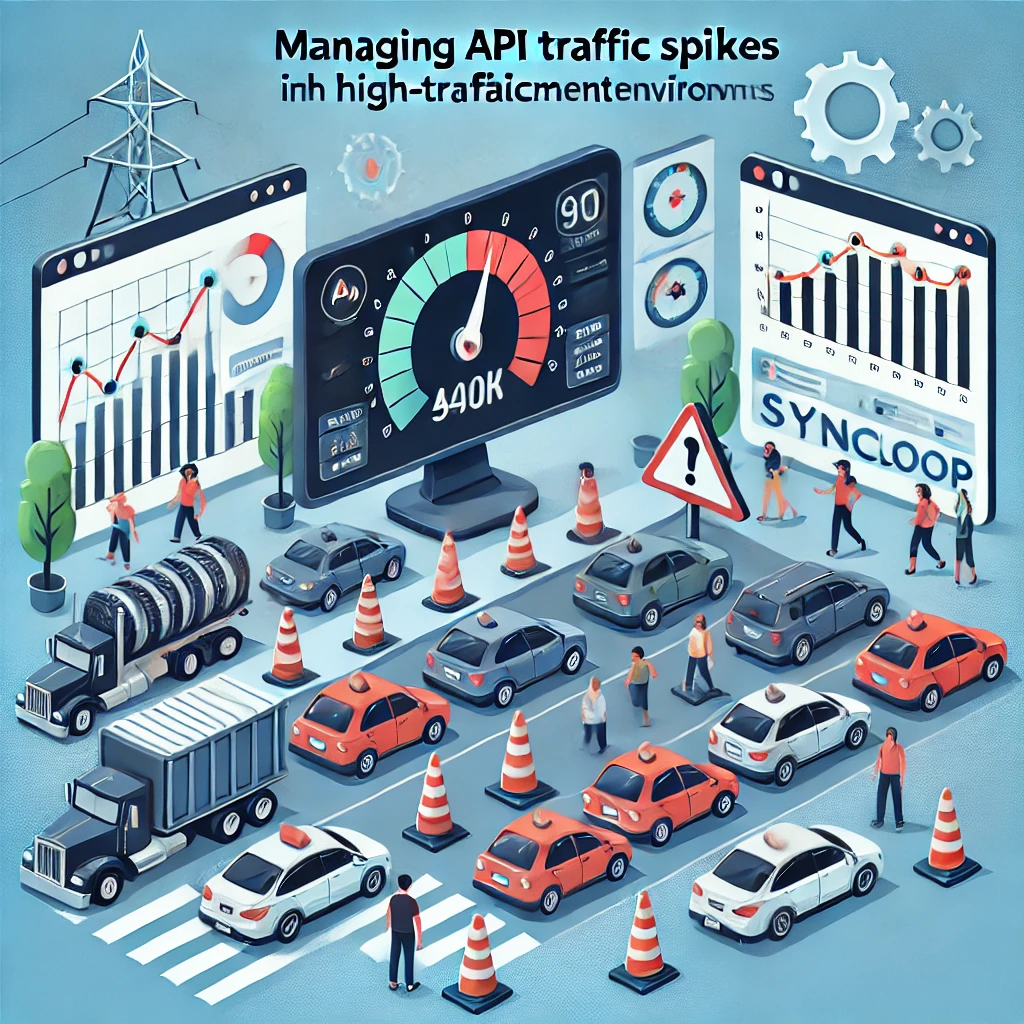Managing API Traffic Spikes in High-Traffic Environments with Syncloop

Syncloop provides tools to monitor, scale, and optimize API performance, ensuring resilience under heavy traffic. This blog explores strategies for managing API traffic spikes with Syncloop and shares best practices for maintaining stability and performance.
The Impact of API Traffic Spikes
Traffic spikes can cause:
- Increased Latency: Slower response times due to resource contention.
- Server Overload: Exceeding backend capacity, leading to service outages.
- Degraded User Experience: Errors and timeouts disrupting workflows.
- Security Vulnerabilities: Spikes masking DDoS attacks or abuse patterns.
- Revenue Loss: Downtime during critical periods affecting business outcomes.
Challenges in Managing API Traffic Spikes
- Unpredictable Surges Traffic spikes are often sudden and vary in intensity.
- Resource Constraints Limited infrastructure resources lead to bottlenecks.
- Inefficient Scaling Delayed or manual scaling fails to match demand.
- Complex Workflows Distributed architectures complicate load management across services.
- Monitoring Gaps Lack of visibility into traffic patterns hinders proactive mitigation.
How Syncloop Helps Manage Traffic Spikes
Syncloop provides tools to address these challenges:
- Real-Time Monitoring Track API traffic, latency, and error rates with live dashboards.
- Auto-Scaling Automatically allocate resources based on traffic patterns.
- Rate Limiting and Throttling Control request volumes to prevent resource overuse.
- Caching Reduce load on backend systems by serving cached responses for frequent requests.
- Load Balancing Distribute traffic efficiently across multiple servers.
- Anomaly Detection Identify unusual traffic patterns indicative of abuse or DDoS attacks.
- Custom Alerts Notify teams of traffic spikes and potential performance issues.
Steps to Manage API Traffic Spikes with Syncloop
Step 1: Monitor API Traffic in Real Time
Enable Syncloop’s monitoring tools to:
- Visualize request rates, response times, and error trends.
- Detect surges in traffic as they occur.
- Identify high-traffic endpoints or clients.
Step 2: Configure Auto-Scaling
Set up Syncloop’s auto-scaling features to:
- Allocate additional servers or resources dynamically during traffic spikes.
- Scale down resources during off-peak periods to optimize costs.
Step 3: Implement Rate Limiting and Throttling
Define rate-limiting rules to:
- Limit requests per client to prevent abuse.
- Enforce throttling for non-critical endpoints to prioritize essential workflows.
Step 4: Enable Caching
Use Syncloop’s caching tools to:
- Serve frequently requested data from cache rather than backend systems.
- Optimize cache expiration policies to balance performance and freshness.
Step 5: Leverage Load Balancing
Distribute traffic across multiple servers or regions using Syncloop’s load balancer. Ensure:
- Even distribution of requests to prevent server overload.
- Failover mechanisms to redirect traffic from unavailable nodes.
Step 6: Detect and Mitigate Anomalies
Configure Syncloop’s anomaly detection to:
- Identify traffic patterns deviating from historical norms.
- Trigger alerts for potential DDoS attacks or abusive behavior.
- Automate mitigation strategies, such as IP blocking or traffic rerouting.
Step 7: Optimize After Spikes
Use post-event analytics to:
- Identify bottlenecks and optimize workflows.
- Refine scaling policies and traffic rules.
- Improve system resilience for future spikes.
Best Practices for Managing API Traffic Spikes
- Design for Scalability Use distributed systems and auto-scaling to handle fluctuating workloads.
- Optimize API Endpoints Reduce unnecessary processing and improve response times for high-traffic endpoints.
- Implement Fail-Safes Use circuit breakers and fallback mechanisms to maintain partial functionality during overloads.
- Monitor Continuously Track traffic patterns and system performance to identify trends and prepare for future spikes.
- Educate API Consumers Share rate limits and best practices with API clients to prevent unintentional abuse.
Example Use Case: Online Streaming Service
An online streaming service uses Syncloop to manage API traffic during major premieres:
- Real-Time Monitoring: Tracks traffic surges as users log in simultaneously.
- Auto-Scaling: Allocates additional resources dynamically to prevent downtime.
- Caching: Serves popular content metadata from cache to reduce backend load.
- Rate Limiting: Limits requests for non-essential features, prioritizing playback APIs.
- Anomaly Detection: Identifies and mitigates potential DDoS attempts during high traffic.
Benefits of Using Syncloop for Traffic Spike Management
- Improved Resilience: Handle sudden surges without compromising performance.
- Enhanced User Experience: Maintain fast response times during peak usage.
- Optimized Costs: Scale resources dynamically to avoid over-provisioning.
- Proactive Mitigation: Detect and address potential issues before they impact users.
- Actionable Insights: Use analytics to refine traffic management strategies.
The Future of Traffic Management
As systems grow in complexity and user bases expand, managing API traffic spikes will become increasingly vital. Syncloop equips developers with the tools to build resilient systems, ensuring seamless performance even under the most demanding conditions.
Image Description
A conceptual illustration of Syncloop’s tools for managing API traffic spikes, featuring real-time monitoring, auto-scaling, and caching. The image highlights seamless traffic handling in high-demand environments.
Back to Blogs